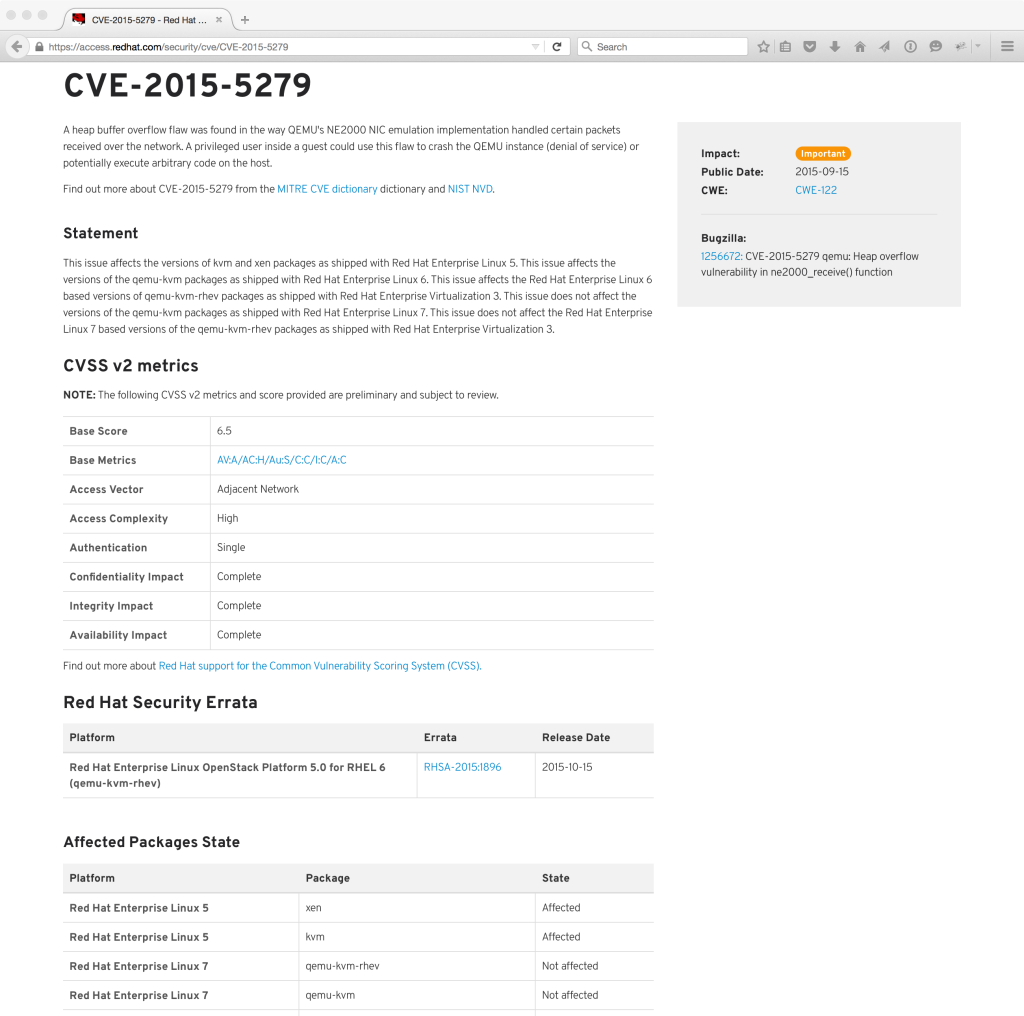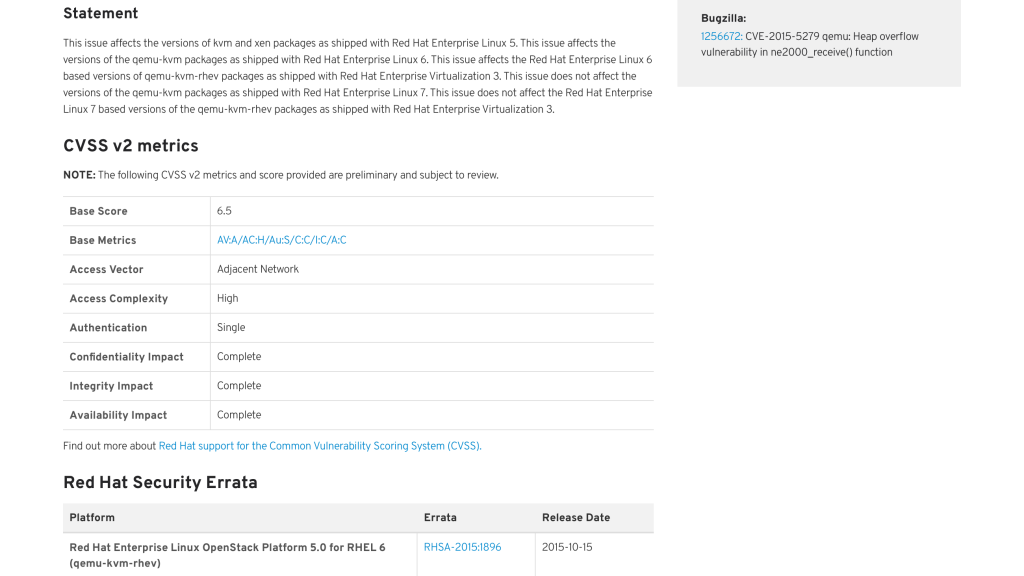Microsoft released six critical vulnerabilities in addition to patching the much-hyped Badlock vulnerability.
Tag Archives: CVE
Mitre Takes On Critics, Set To Revamp CVE Vulnerability Reporting
Mitre Corporation will introduce a pilot program for classifying CVEs in response to critics who contend the agency is failing to keep pace with a massive influx of CVE number requests.
Red Hat CVE Database Revamp
Since 2009, Red Hat has provided details of vulnerabilities with CVE names as part of our mission to provide as much information around vulnerabilities that affect Red Hat products as possible. These CVE pages distill information from a variety of sources to provide an overview of each flaw, including information like a description of the flaw, CVSSv2 scores, impact, public dates, and any corresponding errata that corrected the flaw in Red Hat products.
Over time this has grown to include more information, such as CWE identifiers, statements, and links to external resources that note the flaw (such as upstream advisories, etc.). We’re pleased to note that the CVE pages have been improved yet again to provide even more information.
Beyond just a UI refresh, and deeper integration into the Red Hat Customer Portal, the CVE pages now also display specific “mitigation” information on flaws where such information is provided. This is an area where we highlight certain steps that can be taken to prevent the exploitability of a flaw without requiring a package update. Obviously this is not applicable to all flaws, so it is noted only where it is relevant.
In addition, the CVE pages now display the “affectedness” of certain products in relation to these flaws. For instance, in the past, you would know that an issue affected a certain product either by seeing that an erratum was available (as noted on the CVE page) or by visiting Bugzilla and trying to sort through comments and other metadata that is not easily consumable. The CVE pages now display this information directly on the page so it is no longer required that a visitor spend time poking around in Bugzilla to see if something they are interested in is affected (but has not yet had an erratum released).
To further explain how this works, the pages will not show products that would not be affected by the flaw. For instance, a flaw against the mutt email client would not note that JBoss EAP is unaffected because EAP does not ship, and has never shipped, the mutt email client. However, if a flaw affected mutt on Red Hat Enterprise Linux 6, but not Red Hat Enterprise Linux 5 or 7, the CVE page might show an erratum for Red Hat Enterprise Linux 6 and show that mutt on Red Hat Enterprise Linux 5 and 7 is unaffected. Previously, this may have been noted as part of a statement on the page, but that was by no means guaranteed. You would have to look in Bugzilla to see if any comments or metadata noted this; now it is quite plainly noted on the pages directly.
This section of the page, entitled “Affected Packages State”, is a table that lists the affected platform, package, and a state. This state can be:
- “Affected”: this package is affected by this flaw on this platform
- “Not affected”: this package, which ships on this platform, is not affected by this flaw
- “Fix deferred”: this package is affected by this flaw on this platform, and may be fixed in the future
- “Under investigation”: it is currently unknown whether or not this flaw affects this package on this platform, and it is under investigation
- “Will not fix”: this package is affected by this flaw on this platform, but there is currently no intention to fix it (this would primarily be for flaws that are of Low or Moderate impact that pose no significant risk to customers)
For instance, the page for CVE-2015-5279 would look like this, noting the above affected states:
 By being explicit about the state of packages on the CVE pages, visitors will know exactly what is affected by this CVE, without having to jump through hoops and spend time digging into Bugzilla comments.
By being explicit about the state of packages on the CVE pages, visitors will know exactly what is affected by this CVE, without having to jump through hoops and spend time digging into Bugzilla comments.
Other improvements that come with the recent changes include enhanced searching capabilities. You can now search for CVEs by keyword, so searching for all vulnerabilities that mention “openssl” or “bind” or “XSS” are now possible. In addition, you can filter by year and impact rating.
The Red Hat CVE pages are a primary source of vulnerability information for many, a gateway of sorts that collects the most important information that visitors are often interested in, with links to further sources of information that are of interest to the vulnerability researcher.
Red Hat continues to look for ways to provide extra value to our customers. These enhancements and changes are designed to make your jobs easier, and we believe that they will become an even greater resource for our customers and visitors. We hope you agree!
VENOM, don’t get bitten.
QEMU is a generic and open source machine emulator and virtualizer and is incorporated in some Red Hat products as a foundation and hardware emulation layer for running virtual machines under the Xen and KVM hypervisors.
CVE-2015-3456 (aka VENOM) is a security flaw in the QEMU’s Floppy Disk Controller (FDC) emulation. It can be exploited by a malicious guest user with access to the FDC I/O ports by issuing specially crafted FDC commands to the controller. It can result in guest controlled execution of arbitrary code in, and with privileges of, the corresponding QEMU process on the host. Worst case scenario this can be guest to host exit with the root privileges.
This issue affects all x86 and x86-64 based HVM Xen and QEMU/KVM guests, regardless of their machine type, because both PIIX and ICH9 based QEMU machine types create ISA bridge (ICH9 via LPC) and make FDC accessible to the guest. It is also exposed regardless of presence of any floppy related QEMU command line options so even guests without floppy disk explicitly enabled in the libvirt or Xen configuration files are affected.
We believe that code execution is possible but we have not yet seen any working reproducers that would allow this.
This flaw arises because of an unrestricted indexed write access to the fixed size FIFO memory buffer that FDC emulation layer uses to store commands and their parameters. The FIFO buffer is accessed with byte granularity (equivalent of FDC data I/O port write) and the current index is incremented afterwards. After each issued and processed command the FIFO index is reset to 0 so during normal processing the index cannot become out-of-bounds.
For certain commands (such as FD_CMD_READ_ID and FD_CMD_DRIVE_SPECIFICATION_COMMAND) though the index is either not reset for certain period of time (FD_CMD_READ_ID) or there are code paths that don’t reset the index at all (FD_CMD_DRIVE_SPECIFICATION_COMMAND), in which case the subsequent FDC data port writes result in sequential FIFO buffer memory writes that can be out-of-bounds of the allocated memory. The attacker has full control over the values that are stored and also almost fully controls the length of the write. Depending on how the FIFO buffer is defined, he might also have a little control over the index as in the case of Red Hat Enterprise Linux 5 Xen QEMU package, where the index variable is stored after the memory designated for the FIFO buffer.
Depending on the location of the FIFO memory buffer, this can either result in stack or heap overflow. For all of the Red Hat Products using QEMU the FIFO memory buffer is allocated from the heap.
Red Hat has issued security advisories to fix this flaw and instructions for applying the fix are available on the knowledge-base.
Mitigation
The sVirt and seccomp functionalities used to restrict host’s QEMU process privileges and resource access might mitigate the impact of successful exploitation of this issue. A possible policy-based workaround is to avoid granting untrusted users administrator privileges within guests.
Analysis of the CVE-2013-6435 Flaw in RPM
The RPM Package Manager (RPM) is a powerful command-line driven package management system capable of installing, uninstalling, verifying, querying, and updating software packages. RPM was originally written in 1997 by Erik Troan and Marc Ewing. Since then RPM has been successfully used in all versions of Red Hat Linux and currently in Red Hat Enterprise Linux.
RPM offers considerable advantages over traditional open-source software install methodology of building from source via tar balls, especially when it comes to software distribution and management. This has led to other Linux distributions to accept RPM as either the default package management system or offer it as an alternative to the ones which are default in those distributions.
Like any big, widely used software, over time several features are added to it and also several security flaws are found. On several occasions Red Hat has found and fixed security issues with RPM.
Florian Weimer of Red Hat Product Security discovered an interesting flaw in RPM, which was assigned CVE-2013-6435. Firstly, let’s take a brief look at the structure of an RPM file. It consists of two main parts: the RPM header and the payload. The payload is a compressed CPIO archive of binary files that are installed by the RPM utility. The RPM header, among other things, contains a cryptographic checksum of all the installed files in the CPIO archive. The header also contains a provision for a cryptographic signature. The signature works by performing a mathematical function on the header and archive section of the file. The mathematical function can be an encryption process, such as PGP (Pretty Good Privacy), or a message digest in the MD5 format.
If the RPM is signed, one can use the corresponding public key to verify the integrity and even the authenticity of the package. However, RPM only checked the header and not the payload during the installation.
When an RPM is installed, it writes the contents of the package to its target directory and then verifies its checksum against the value in the header. If the checksum does not match, that means something is wrong with the package (possibly someone has tampered with it) and the file is removed. At this point RPM refuses to install that particular package.
Though this may seem like the correct way to handle things, it has a bad consequence. Let’s assume RPM installs a file in the /etc/cron.d directory and then verifies its checksum. This offers a small race-window, in which crond can run before the checksum is found to be incorrect and the file is removed. There are several ways to prolong this window as well. So in the end we achieve arbitrary code execution as root, even though the system administrator assumes that the RPM package was never installed.
The approach Red Hat used to solve the problem is:
- Require the size in the header to match with the size of the file in the payload. This prevents anyone from tampering with the payload, because the header is cryptographically verified. (This fix is already present in the upstream version of RPM)
- Set restrictive permissions while a file is being unpacked from an RPM package. This will only allow root to access those file. Also, several programs, including cron, perform a check for permission sanity before running those files.
Another approach to mitigate this issue is the use of the O_TMPFILE flag. Linux kernel 3.11 and above introduced this flag, which can be passed to open(2), to simplify the creation of secure temporary files. Files opened with the O_TMPFILE flag are created, but they are not visible in the file system. As soon as they are closed, they are deleted. There are two uses for these files: race-free temporary files and creation of initially unreachable files. These unreachable files can be written to or changed same as regular files. RPM could use this approach to create a temporary, unreachable file, run a checksum on it, and either delete it or atomically link it to set the file up, without being vulnerable to the attack described above. However, as mentioned above, this feature is only available in Linux kernel 3.11 and above, was added to glibc 2.19, and is slowly making its way into GNU/Linux distributions.
The risk mentioned above is greatly reduced if the following precautions are followed:
- Always check signatures of RPM packages before installing them. Red Hat RPMs are signed with cryptographic keys provided at https://access.redhat.com/security/team/key. When installing RPMs from Red Hat or Fedora repositories, Yum will automatically validate RPM packages via the respective public keys, unless explicitly told not to (via the “nogpgcheck” option and configuration directive).
- Package downloads via Red Hat software repositories are protected via TLS/SSL so it is extremely difficult to tamper with them in transit. Fedora uses a whole-file hash chain rooted in a hash downloaded over TLS/SSL from a Fedora-run central server.
The above issue (CVE-2013-6435) has been fixed along with another issue (CVE-2014-8118), which is a potentially exploitable crash in the CPIO parser.
Red Hat customers should update to the latest versions of RPM via the following security advisories:
https://rhn.redhat.com/errata/RHSA-2014-1974.html
https://rhn.redhat.com/errata/RHSA-2014-1975.html
https://rhn.redhat.com/errata/RHSA-2014-1976.html

